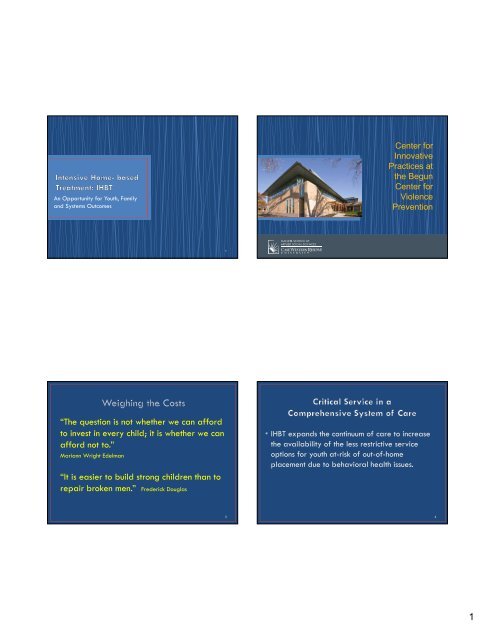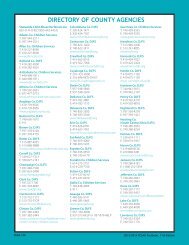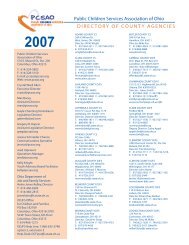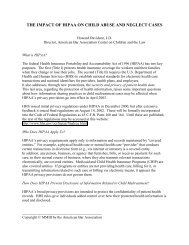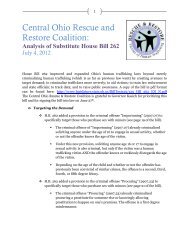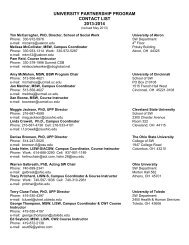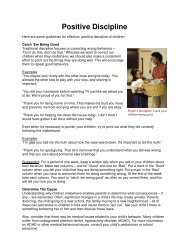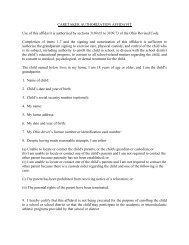âThe question is not whether we can afford to invest in every child; it ...
âThe question is not whether we can afford to invest in every child; it ...
âThe question is not whether we can afford to invest in every child; it ...
You also want an ePaper? Increase the reach of your titles
YUMPU automatically turns print PDFs into web optimized ePapers that Google loves.
An Opportun<strong>it</strong>y for Youth, Family<br />
and Systems Outcomes<br />
Center for<br />
Innovative<br />
Practices at<br />
the Begun<br />
Center for<br />
Violence<br />
Prevention<br />
1<br />
“The <strong>question</strong> <strong>is</strong> <strong>not</strong> <strong>whether</strong> <strong>we</strong> <strong>can</strong> <strong>afford</strong><br />
<strong>to</strong> <strong><strong>in</strong>vest</strong> <strong>in</strong> <strong>every</strong> <strong>child</strong>; <strong>it</strong> <strong>is</strong> <strong>whether</strong> <strong>we</strong> <strong>can</strong><br />
<strong>afford</strong> <strong>not</strong> <strong>to</strong>.”<br />
Mariann Wright Edelman<br />
“It <strong>is</strong> easier <strong>to</strong> build strong <strong>child</strong>ren than <strong>to</strong><br />
repair broken men.” Frederick Douglas<br />
• IHBT expands the cont<strong>in</strong>uum of care <strong>to</strong> <strong>in</strong>crease<br />
the availabil<strong>it</strong>y of the less restrictive service<br />
options for youth at-r<strong>is</strong>k of out-of-home<br />
placement due <strong>to</strong> behavioral health <strong>is</strong>sues.<br />
3<br />
4<br />
1
Home-Based Delivery Model<br />
Location of Service<br />
Home and Commun<strong>it</strong>y<br />
• IHBT <strong>is</strong> an <strong>in</strong>tensive, time-lim<strong>it</strong>ed mental health service for youth w<strong>it</strong>h<br />
serious emotional d<strong>is</strong>abil<strong>it</strong>ies and their families, provided <strong>in</strong> the home,<br />
school and commun<strong>it</strong>y where the youth lives, w<strong>it</strong>h the goal of<br />
stabiliz<strong>in</strong>g mental health concerns, and safely ma<strong>in</strong>ta<strong>in</strong><strong>in</strong>g the youth <strong>in</strong><br />
the least restrictive, most normative environment.<br />
• Comprehensive set of services (CPST; Behavioral Health Counsel<strong>in</strong>g<br />
and Therapy; Cr<strong>is</strong><strong>is</strong> Response; mental health assessment; supportive<br />
services) <strong>in</strong>tegrated by a team of providers <strong>in</strong><strong>to</strong> a seamless set of<br />
services delivered <strong>to</strong> the family.<br />
• Ma<strong>in</strong> Purposes:<br />
• Placement prevention<br />
• Reunification<br />
• Stabilization and safety<br />
5<br />
Intens<strong>it</strong>y<br />
Frequency: 2 <strong>to</strong> 5 sessions per <strong>we</strong>ek<br />
Duration: 4 <strong>to</strong> 8 hours per <strong>we</strong>ek<br />
Cr<strong>is</strong><strong>is</strong> Response & Availabil<strong>it</strong>y 24/7<br />
Active safety plann<strong>in</strong>g & moni<strong>to</strong>r<strong>in</strong>g Ongo<strong>in</strong>g<br />
Small Caseloads<br />
4 <strong>to</strong> 6 families<br />
Flexible Schedul<strong>in</strong>g<br />
Convenient <strong>to</strong> family<br />
Treatment Duration<br />
3 <strong>to</strong> 6 months<br />
Cross-system Collaboration Child and Family Team Meet<strong>in</strong>gs<br />
Superv<strong>is</strong>ory Availabil<strong>it</strong>y 24/7<br />
Skillful Advocacy<br />
Comprehensive Service Array<br />
Promote accommodations and<br />
protect rights<br />
CPST, Individual and Family<br />
Therapy, Cr<strong>is</strong><strong>is</strong> response, Assessment<br />
System of Care Service Philosophy<br />
Home-Based Service Delivery<br />
Resiliency-Oriented Perspective<br />
Multidimensional Assessment<br />
Comprehensive Treatment Array<br />
Matched <strong>to</strong> Needs and Strengths<br />
• Youth w<strong>it</strong>h Serious Emotional D<strong>is</strong>turbance (SED) w<strong>it</strong>h<br />
functional impairments<br />
• Less <strong>in</strong>tensive services <strong>we</strong>re unsuccessful<br />
• Multiple system <strong>in</strong>volvement<br />
• At-r<strong>is</strong>k of placement due <strong>to</strong> safety <strong>is</strong>sues<br />
• Multiple r<strong>is</strong>k fac<strong>to</strong>rs; Few protective fac<strong>to</strong>rs<br />
• Skill set defic<strong>it</strong>s<br />
• Youth need add<strong>it</strong>ional supports, active facil<strong>it</strong>ation, and<br />
accommodations for success<br />
7<br />
8<br />
2
• Youth w<strong>it</strong>h serious emotional d<strong>is</strong>orders<br />
• At r<strong>is</strong>k for out-of-home placement; or<br />
• Return<strong>in</strong>g from out of home placement; or<br />
• Requires a high level of mental health <strong>in</strong>terventions<br />
<strong>to</strong> stabilize potential safety concerns<br />
• Is under the age of 18; or<br />
• Youth age 18 through 21 who are still liv<strong>in</strong>g at<br />
home and attend<strong>in</strong>g high school or under the<br />
jur<strong>is</strong>diction of a<strong>not</strong>her <strong>child</strong> serv<strong>in</strong>g system<br />
• System has <strong>not</strong> engaged youth and family effectively<br />
• Families who have difficulty w<strong>it</strong>h service access (work,<br />
transportation, poverty)<br />
• High stress – Low resource<br />
• High family conflict<br />
• Current parent<strong>in</strong>g skill set unsuccessful <strong>in</strong> deal<strong>in</strong>g w<strong>it</strong>h youth's<br />
mental health needs<br />
• Parents need signifi<strong>can</strong>t levels of support (few external<br />
supports)<br />
• Trust <strong>is</strong>sues w<strong>it</strong>h the “system”<br />
9<br />
• Foster Care<br />
• Therapeutic Foster Care<br />
• Group Home<br />
• Psychiatric Hosp<strong>it</strong>alization<br />
• Residential Treatment Facil<strong>it</strong>ies (Unlocked <strong>to</strong><br />
locked)<br />
• Incarceration<br />
• Homebuilders (1974): Orig<strong>in</strong>al home-based model; often referred<br />
<strong>to</strong> as family preservation; target population <strong>is</strong> youth at-r<strong>is</strong>k for abuse<br />
and neglect (length of stay- 4 <strong>to</strong> 6 <strong>we</strong>eks)<br />
• Kaleidoscope (1973) Karl Denn<strong>is</strong>; wraparound model developed (no<br />
eject no reject policy)<br />
• Philadelphia Child Guidance Model: Structural Family Therapy<br />
home-based therapy model<br />
• Mult<strong>is</strong>ystemic Therapy (MST): EBP for juvenile justice 3- 5 months<br />
• IHBT: Ohio’s <strong>in</strong>tensive home-based treatment model: for youth w<strong>it</strong>h<br />
SED who are at-r<strong>is</strong>k of placement; return<strong>in</strong>g from placement; or have<br />
a signifi<strong>can</strong>t safety/r<strong>is</strong>k <strong>is</strong>sue that potentially puts them at r<strong>is</strong>k of<br />
placement<br />
• Integrated co-occurr<strong>in</strong>g treatment (ICT): for youth w<strong>it</strong>h co-occurr<strong>in</strong>g<br />
substance use and mental health d<strong>is</strong>orders (3 <strong>to</strong> 6 months)<br />
11<br />
12<br />
3
Home-Based Delivery Model<br />
Location of Service<br />
Home and Commun<strong>it</strong>y<br />
Intens<strong>it</strong>y<br />
Frequency: 2 <strong>to</strong> 5 sessions per <strong>we</strong>ek<br />
Duration: 4 <strong>to</strong> 8 hours per <strong>we</strong>ek<br />
Cr<strong>is</strong><strong>is</strong> Response & Availabil<strong>it</strong>y 24/7<br />
Active safety plann<strong>in</strong>g & moni<strong>to</strong>r<strong>in</strong>g Ongo<strong>in</strong>g<br />
Small Caseloads<br />
4 <strong>to</strong> 6 families<br />
IHBT<br />
Services delivered <strong>in</strong> the home and<br />
commun<strong>it</strong>y<br />
24/7 availabil<strong>it</strong>y & response by IHBT<br />
team<br />
Outpatient<br />
Cl<strong>in</strong>ic-based<br />
No 24/7 availabil<strong>it</strong>y by team<br />
Flexible Schedul<strong>in</strong>g<br />
Convenient <strong>to</strong> family<br />
Frequency & duration matches need<br />
One hour <strong>we</strong>ekly appo<strong>in</strong>tments<br />
Treatment Duration<br />
3 <strong>to</strong> 6 months<br />
Flexible Schedul<strong>in</strong>g<br />
Appo<strong>in</strong>tments dur<strong>in</strong>g office hours<br />
Cross-system Collaboration<br />
Child and Family Team Meet<strong>in</strong>gs<br />
Lead role <strong>in</strong> service coord<strong>in</strong>ation<br />
Lim<strong>it</strong>ed opportun<strong>it</strong>ies for collaboration<br />
Superv<strong>is</strong>ory Availabil<strong>it</strong>y 24/7<br />
Small Caseloads 30<br />
Skillful Advocacy<br />
Comprehensive Service Array<br />
Promote accommodations and<br />
protect rights<br />
CPST, Individual and Family<br />
Therapy, Cr<strong>is</strong><strong>is</strong> response, Assessment<br />
13<br />
Time-lim<strong>it</strong>ed<br />
Comprehensive mix of services<br />
Services are ongo<strong>in</strong>g<br />
Therapy only<br />
14<br />
IHBT<br />
Services delivered <strong>in</strong> the home and<br />
commun<strong>it</strong>y<br />
24/7 availabil<strong>it</strong>y & response by team<br />
Frequency & duration matches need<br />
Flexible Schedul<strong>in</strong>g<br />
Lead cl<strong>in</strong>ical & service coord<strong>in</strong>ation role<br />
Small Caseloads
• Intens<strong>it</strong>y<br />
• Strength-based partnerships<br />
• Delivered <strong>in</strong> the home, school and commun<strong>it</strong>y<br />
• Small caseloads<br />
• Cr<strong>is</strong><strong>is</strong> availabil<strong>it</strong>y and response<br />
• Safety plann<strong>in</strong>g<br />
• System collaboration<br />
• Flexible service delivery<br />
• Time lim<strong>it</strong>ed<br />
• Frequency: 2 <strong>to</strong> 5 meet<strong>in</strong>gs <strong>we</strong>ekly<br />
(depends on stage of <strong>in</strong>tervention: <strong>in</strong>creased frequency<br />
at beg<strong>in</strong>n<strong>in</strong>g and dur<strong>in</strong>g cr<strong>is</strong><strong>is</strong> periods; decreased<br />
frequency near time of d<strong>is</strong>charge)<br />
• Duration: Length of sessions matches youth and family<br />
needs and averages a <strong>to</strong>tal of 4 <strong>to</strong> 8 hours per <strong>we</strong>ek<br />
per family<br />
• Services are generally more <strong>in</strong>tensive at the beg<strong>in</strong>n<strong>in</strong>g<br />
of treatment and decrease over time as the youth and<br />
family’s cop<strong>in</strong>g skills develop<br />
17<br />
18<br />
• A m<strong>in</strong>imum of 3 hours per <strong>we</strong>ek of IHBT service<br />
which must <strong>in</strong>clude at least:<br />
‣ 2 separate face-<strong>to</strong>-face contacts; and<br />
‣ 1 contact w<strong>it</strong>h the youth or family.<br />
• Total service time may <strong>in</strong>clude phone contacts and<br />
collateral face <strong>to</strong> face contacts<br />
• Be strength-based and family-driven, w<strong>it</strong>h the youth<br />
and family regarded as equal partners w<strong>it</strong>h the IHBT<br />
staff <strong>in</strong> all aspects of develop<strong>in</strong>g the service plan and<br />
service delivery.<br />
19<br />
20<br />
5
• IHBT <strong>is</strong> provided <strong>in</strong> the home, school, and<br />
commun<strong>it</strong>y where the <strong>child</strong> lives and functions<br />
• No more than 25% of <strong>to</strong>tal service time <strong>is</strong><br />
delivered <strong>in</strong> an office sett<strong>in</strong>g (per service, per<br />
<strong>child</strong>)<br />
• Small caseloads<br />
• A maximum caseload, per FTE, averag<strong>in</strong>g 8 or less<br />
over any six month period sampled;<br />
• Caseload per full time equivalent staff shall <strong>not</strong><br />
exceed 10 at any po<strong>in</strong>t <strong>in</strong> time.<br />
21<br />
22<br />
• Cr<strong>is</strong><strong>is</strong> response <strong>is</strong> available 24 hours a day, 7 days a <strong>we</strong>ek.<br />
• Cr<strong>is</strong><strong>is</strong> response may be provided through wr<strong>it</strong>ten agreement<br />
w<strong>it</strong>h a<strong>not</strong>her agency as long as one IHBT staff <strong>is</strong> accessible<br />
<strong>to</strong> the provider agency, and <strong>is</strong> available <strong>to</strong> the client and<br />
family as needed.<br />
• Active safety plann<strong>in</strong>g and moni<strong>to</strong>r<strong>in</strong>g<br />
• Family <strong>is</strong> <strong>in</strong>volved and <strong>in</strong>formed<br />
• Each family receiv<strong>in</strong>g IHBT services shall be assessed for r<strong>is</strong>k<br />
and safety <strong>is</strong>sues and shall have a jo<strong>in</strong>tly completed safety plan<br />
that <strong>is</strong> available <strong>to</strong> the family and <strong>is</strong> <strong>in</strong>structive of steps <strong>to</strong> take<br />
<strong>in</strong> the event of a cr<strong>is</strong><strong>is</strong>.<br />
23<br />
24<br />
6
• Pro-active cross-system collaboration and service<br />
coord<strong>in</strong>ation<br />
• IHBT providers establ<strong>is</strong>h collaborative relationships<br />
w<strong>it</strong>h other <strong>child</strong> and family-serv<strong>in</strong>g systems w<strong>it</strong>h the<br />
goal of enhanced service coord<strong>in</strong>ation across<br />
providers and systems<br />
• The service <strong>is</strong> flexible and <strong>in</strong>dividually tailored <strong>to</strong><br />
meet the needs of the client and family<br />
• Appo<strong>in</strong>tments are made at a time that <strong>is</strong> convenient <strong>to</strong><br />
the client and family, <strong>in</strong>clud<strong>in</strong>g even<strong>in</strong>gs and <strong>we</strong>ekends<br />
if necessary<br />
25<br />
26<br />
• IHBT <strong>is</strong> time lim<strong>it</strong>ed and should <strong>not</strong> exceed 6<br />
months length of stay.<br />
• A cont<strong>in</strong>ued stay review must be completed for<br />
each client receiv<strong>in</strong>g IHBT beyond 6 months,<br />
and <strong>every</strong> forty-five days thereafter.<br />
• Providers are culturally competent and responsive <strong>to</strong><br />
the unique cultural, racial, spir<strong>it</strong>ual and ethnic<br />
differences of the families they serve<br />
• Services are <strong>in</strong>dividualized and build on the strengths<br />
of the <strong>child</strong>/family’s race, culture, and ethnic<strong>it</strong>y<br />
27<br />
28<br />
7
• The rights and privacy of youth and families<br />
are protected, and effective advocacy efforts<br />
are promoted <strong>to</strong> ass<strong>is</strong>t the family <strong>in</strong> system<br />
navigation<br />
• Superv<strong>is</strong>or support and 24/7 availabil<strong>it</strong>y <strong>is</strong> a<br />
key aspect of successful IHBT<br />
• Superv<strong>is</strong>or has a designated responsibil<strong>it</strong>y <strong>to</strong><br />
the team<br />
• Pro-active consultation and full access are<br />
<strong>in</strong>tegral components of superv<strong>is</strong>ion<br />
29<br />
30<br />
Engagement and Assessment<br />
• Engagement (youth, family, & collaborative partners)<br />
• Cr<strong>is</strong><strong>is</strong> Stabilization and Safety Plann<strong>in</strong>g<br />
• Assessment<br />
Treatment<br />
• Evidenced-based <strong>in</strong>dividual and family treatments and<br />
supports<br />
• Skill Build<strong>in</strong>g, Skill Consolidation, and Generalization<br />
• High engagement and <strong>in</strong>tens<strong>it</strong>y for first third of<br />
services<br />
• Medium <strong>in</strong>tens<strong>it</strong>y 2 nd third of services<br />
• Last two <strong>to</strong> four <strong>we</strong>eks decreased <strong>in</strong>tens<strong>it</strong>y<br />
w<strong>it</strong>h <strong>in</strong>creased reliance on <strong>in</strong>formal supports<br />
Enhancement of Pos<strong>it</strong>ive Support Network<br />
• L<strong>in</strong>kages, Closure, & Follow-up<br />
31<br />
32<br />
8
• Shared burden- shared r<strong>is</strong>k<br />
• No s<strong>in</strong>gle system <strong>can</strong> manage the multiple <strong>is</strong>sues<br />
of at-r<strong>is</strong>k youth and their families alone<br />
• Mutual responsibil<strong>it</strong>ies: <strong>we</strong> all play a role<br />
•Youth and family<br />
•Providers<br />
•Child-Serv<strong>in</strong>g Systems<br />
•Commun<strong>it</strong>y (supports)<br />
• Service delivered where the youth lives and functions: home,<br />
school, and commun<strong>it</strong>y at times that are convenient <strong>to</strong> the<br />
family<br />
• Access <strong>to</strong> <strong>in</strong>formation<br />
–Family dynamics and <strong>in</strong>teractional patterns<br />
–Recovery environments<br />
• Access <strong>to</strong> people<br />
–Family<br />
–School<br />
–Court<br />
–Commun<strong>it</strong>y<br />
–Natural supports<br />
33<br />
• Access for <strong>in</strong>terventions: implemented where behaviors occur<br />
34<br />
• Least restrictive environment<br />
• Treatment responsiveness and pers<strong>is</strong>tence<br />
• Advocacy and protection of rights<br />
• Integrated, coord<strong>in</strong>ated, and comprehensive services<br />
• Culturally and l<strong>in</strong>gu<strong>is</strong>tically competent services<br />
• Strength-based perspective<br />
• Youth guided and family driven services<br />
• Youth and family partnerships<br />
• Services are responsive and delivered at a time that <strong>is</strong><br />
convenient <strong>to</strong> the youth and family<br />
• Service <strong>in</strong>tens<strong>it</strong>y matches the complex and multiple needs<br />
of each youth and their family.<br />
• Providers “recognize that needs <strong>can</strong> be complex, that<br />
change <strong>is</strong> sometimes very difficult <strong>to</strong> achieve, and comm<strong>it</strong><br />
<strong>to</strong> a mutual process of extreme pers<strong>is</strong>tence <strong>in</strong> the delivery<br />
of services and supports (VanDenBerg, 2002).”<br />
36<br />
9
• Youth and families have access <strong>to</strong> comprehensive<br />
service array<br />
• Services are <strong>in</strong>tegrated and seamless <strong>to</strong> family<br />
• S<strong>in</strong>gle Po<strong>in</strong>t of Cl<strong>in</strong>ical Responsibil<strong>it</strong>y: IHBT providers<br />
take a lead role <strong>in</strong> facil<strong>it</strong>at<strong>in</strong>g the coord<strong>in</strong>ation of<br />
formal and <strong>in</strong>formal services and supports, as guided<br />
by the youth and family.<br />
• Cultural m<strong>in</strong>dfulness<br />
• Respectful humil<strong>it</strong>y<br />
• Make no value assumptions<br />
• Utilize family’s unique values and culture <strong>in</strong><br />
plann<strong>in</strong>g process<br />
• Understand that youth’s peer group culture may<br />
have different value set than family’s value set<br />
• Resource and support build<strong>in</strong>g<br />
• R<strong>is</strong>k reduction & asset promotion<br />
• Facil<strong>it</strong>ation of accommodations across life<br />
doma<strong>in</strong>s<br />
• Youth <strong>can</strong> rema<strong>in</strong> <strong>in</strong> their homes and receive the<br />
necessary behavioral health services needed for<br />
commun<strong>it</strong>y stabil<strong>it</strong>y.<br />
• Reduced out of home placements<br />
• 86% <strong>in</strong> recent 15 s<strong>it</strong>e IHBT evaluation (<strong>to</strong>tal youth<br />
served)<br />
• Build developmental skill sets<br />
39<br />
10
• Evidence shows that offer<strong>in</strong>g a full range of<br />
commun<strong>it</strong>y-based alternatives <strong>is</strong> more effective<br />
than hosp<strong>it</strong>alization and emergency room<br />
treatment<br />
• The Comm<strong>is</strong>sion’s f<strong>in</strong>al report endorses the<br />
expansion of home and commun<strong>it</strong>y-based<br />
services and the move <strong>to</strong>ward the use of<br />
evidence-based practices<br />
President’s New Freedom Comm<strong>is</strong>sion on Mental Health<br />
State Months Post IFPS % In Home<br />
Kansas 12 91%<br />
Wayne Co., Michigan 6 88<br />
Kentucky 12 87<br />
Marion Co., Indiana 6 83<br />
North Carol<strong>in</strong>a 12 82<br />
M<strong>is</strong>souri 12 79<br />
Wash<strong>in</strong>g<strong>to</strong>n 6 77<br />
Mean 84%<br />
41<br />
• Randomly assigned high-r<strong>is</strong>k families <strong>to</strong> e<strong>it</strong>her family<br />
preservation services (home-based) or trad<strong>it</strong>ional <strong>child</strong><br />
<strong>we</strong>lfare services <strong>in</strong>clud<strong>in</strong>g foster care.<br />
• At 6 months after IFPS, 88% of <strong>child</strong>ren <strong>we</strong>re liv<strong>in</strong>g at<br />
home compared <strong>to</strong> only 17% <strong>in</strong> the non-IFPS group.<br />
• At 12 months, 93% of IFPS <strong>child</strong>ren <strong>we</strong>re at home<br />
compared <strong>to</strong> 43% of non-IFPS <strong>child</strong>ren.<br />
Placements Avoided<br />
• 86% of youth served, all at-r<strong>is</strong>k of out of home placement, <strong>we</strong>re<br />
ma<strong>in</strong>ta<strong>in</strong>ed at home and <strong>in</strong> the commun<strong>it</strong>y at d<strong>is</strong>charge<br />
• 100% of youth ages 4 <strong>to</strong> 6 rema<strong>in</strong>ed <strong>in</strong> their homes safely (all<br />
PCSAO referrals)<br />
School Success<br />
• Pass<strong>in</strong>g grades <strong>in</strong>creased from 65 <strong>to</strong> 77%;<br />
• D<strong>is</strong>cipl<strong>in</strong>ary problems decreased from 68 <strong>to</strong> 49%;<br />
Juvenile Justice Outcomes<br />
• 50% drop <strong>in</strong> youth arrested (44% <strong>to</strong> 21%);youth on probation<br />
(27.5 <strong>to</strong> 13%);youth deta<strong>in</strong>ed (13.5% <strong>to</strong> 7.1%)<br />
43<br />
3/16/2012 44<br />
11
60<br />
50<br />
40<br />
30<br />
20<br />
10<br />
0<br />
34.3<br />
21.4<br />
Problems<br />
37.4<br />
50.5<br />
14<br />
10.8 8.99<br />
6.09<br />
Function<strong>in</strong>g Hopefulness Sat<strong>is</strong>faction<br />
p
What Cost Analys<strong>is</strong> Shows<br />
• Estimate the present value of sav<strong>in</strong>g a<br />
14-year-old high r<strong>is</strong>k juvenile from a<br />
life of crime <strong>to</strong> range from $2.6 <strong>to</strong><br />
$5.3 million (p. 25)<br />
“Intensive Family Preservation Programs that adhere<br />
closely <strong>to</strong> the Homebuilders model signifi<strong>can</strong>tly<br />
reduce out-of-home placements and subsequent<br />
abuse and neglect. We estimate that such programs<br />
produce $2.54 of benef<strong>it</strong>s for <strong>every</strong> dollar of cost.”<br />
Wash<strong>in</strong>g<strong>to</strong>n State Inst<strong>it</strong>ute for Public Policy (WSIPP): (Miller,<br />
2006)<br />
49<br />
Placement Type<br />
Average Cost Per Diem Annualized Cost System(s) Impacted<br />
Foster Care Level IV $123.90 $45,224 Local Job and Family<br />
Services<br />
Group Home $125 $45, 625 Local Job and Family<br />
Services; Juvenile Courts<br />
Residential<br />
Treatment (nonsecure)<br />
Residential<br />
Treatment (secure)<br />
Juvenile<br />
Comm<strong>it</strong>ment<br />
$200.56 $73,204 Local Job and Family<br />
Services; Juvenile Courts;<br />
School Systems<br />
$335 $122,275 Local Job and Family<br />
Services; Juvenile Courts;<br />
School Systems<br />
$440 $145,200 (11.9<br />
months)<br />
ODYS; Local Juvenile<br />
Courts<br />
IHBT (per treatment ep<strong>is</strong>ode) $7,000 <strong>to</strong> 10,000<br />
Foster Care Level I (per year) $18,203*<br />
Foster Care Level II $26,076*<br />
Foster Care Level III $32, 237*<br />
Foster Care Level IV $45,224*<br />
Group Home $45,625*<br />
Residential Non-Secure $73,204<br />
Residential Secure $122,275<br />
IHBT (average cost per treatment ep<strong>is</strong>ode) $7,500 All<br />
Incarceration $160,600<br />
* Does <strong>not</strong> <strong>in</strong>clude Medicaid and Medicaid match costs for mental health services<br />
3/16/2012 51 52<br />
13
Information Calculation Cost Benef<strong>it</strong><br />
86% of 394 youth served<br />
rema<strong>in</strong>ed <strong>in</strong> the home (339)<br />
Average cost of placement<br />
$57,788<br />
339 youth<br />
X<br />
$57,788 =<br />
$19,590,132<br />
IHBT Grant FY 08 & 09 (394 youth) 394 x $7,500 =<br />
$2,955,000<br />
Typical Case Rate for IHBT =<br />
$7,500<br />
55 youth placed 55 x $57,788=<br />
$3,178,340<br />
Average cost of placement<br />
$57,788<br />
394 youth served <strong>in</strong> IHBT Grant<br />
FY 08 and 09<br />
Cost saved m<strong>in</strong>us cost of IHBT<br />
and cost of youth placed<br />
$13,456,792 divided by <strong>to</strong>tal<br />
youth served (394)<br />
Total Benef<strong>it</strong> (19,590,132 –<br />
3,178,340)/Total Service Cost<br />
(2,955,000)<br />
$2,955,00<br />
Total cost of<br />
IHBT<br />
$3,178,340<br />
Total cost of<br />
placement<br />
For <strong>every</strong> ($1)<br />
dollar spent <strong>in</strong><br />
IHBT<br />
$19,590,132<br />
Placement costs avoided<br />
Total Benef<strong>it</strong><br />
$13,456,792 (for all youth<br />
served)<br />
$34,154 (Cost sav<strong>in</strong>gs per<br />
youth)<br />
$5.55 <strong>is</strong> returned <strong>in</strong> placement<br />
costs avoided<br />
3/16/2012 53<br />
• Over $16.4 million <strong>in</strong> placement costs saved at the<br />
cost of approximately $3 million (IHBT for 394 youth)<br />
• Total Cost Benef<strong>it</strong> over $13.4 million saved for 394<br />
youth served (IHBT grant 2009)<br />
• The <strong>to</strong>tal cost sav<strong>in</strong>gs per youth <strong>is</strong> $34,154<br />
• For <strong>every</strong> dollar spent <strong>in</strong> IHBT/MST there was a<br />
return of $5.55 or 555% <strong>in</strong> placement costs avoided.<br />
3/16/2012 54<br />
• Technical Ass<strong>is</strong>tance <strong>is</strong> needed <strong>to</strong> maximize effectiveness of<br />
IHBT<br />
• Agency/program level fund<strong>in</strong>g requires more than Medicaid<br />
• A uniform data collection system <strong>is</strong> necessary <strong>in</strong> order <strong>to</strong><br />
provide timely cl<strong>in</strong>ical feedback and track qual<strong>it</strong>y improvement<br />
• Stakeholders/funders <strong>in</strong>creas<strong>in</strong>gly rely<strong>in</strong>g on data <strong>to</strong> make<br />
f<strong>in</strong>ancial dec<strong>is</strong>ions<br />
• Multiple partners and multiple systems are needed <strong>to</strong> support<br />
implementation<br />
• High level tra<strong>in</strong><strong>in</strong>g and ongo<strong>in</strong>g coach<strong>in</strong>g and moni<strong>to</strong>r<strong>in</strong>g of<br />
fidel<strong>it</strong>y<br />
So, where <strong>is</strong><br />
Ohio on IHBT?<br />
ODMH comm<strong>it</strong>ted <strong>to</strong> add<strong>in</strong>g IHBT <strong>to</strong><br />
Medicaid service menu by FY ‘13<br />
IHBT workgroup completed <strong>it</strong>s review<br />
ODMH conduct<strong>in</strong>g rate sett<strong>in</strong>g exerc<strong>is</strong>e<br />
Next Steps: Prepare SPA and subm<strong>it</strong> <strong>to</strong><br />
CMS<br />
Tra<strong>in</strong><strong>in</strong>g and roll out<br />
Current IHBT status<br />
• Approximately 20+ certified IHBT s<strong>it</strong>es<br />
• 16 MST teams for 10 counties<br />
• Other non-certified <strong>in</strong> home programs<br />
3/16/2012 55<br />
56<br />
14
Patrick Kanary patrick.kanary@case.edu<br />
Richard Shepler richard.shepler@case.edu<br />
Center for Innovative Practices<br />
Begun Center for Violence Prevention, CWRU<br />
57<br />
15


